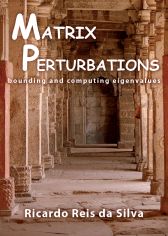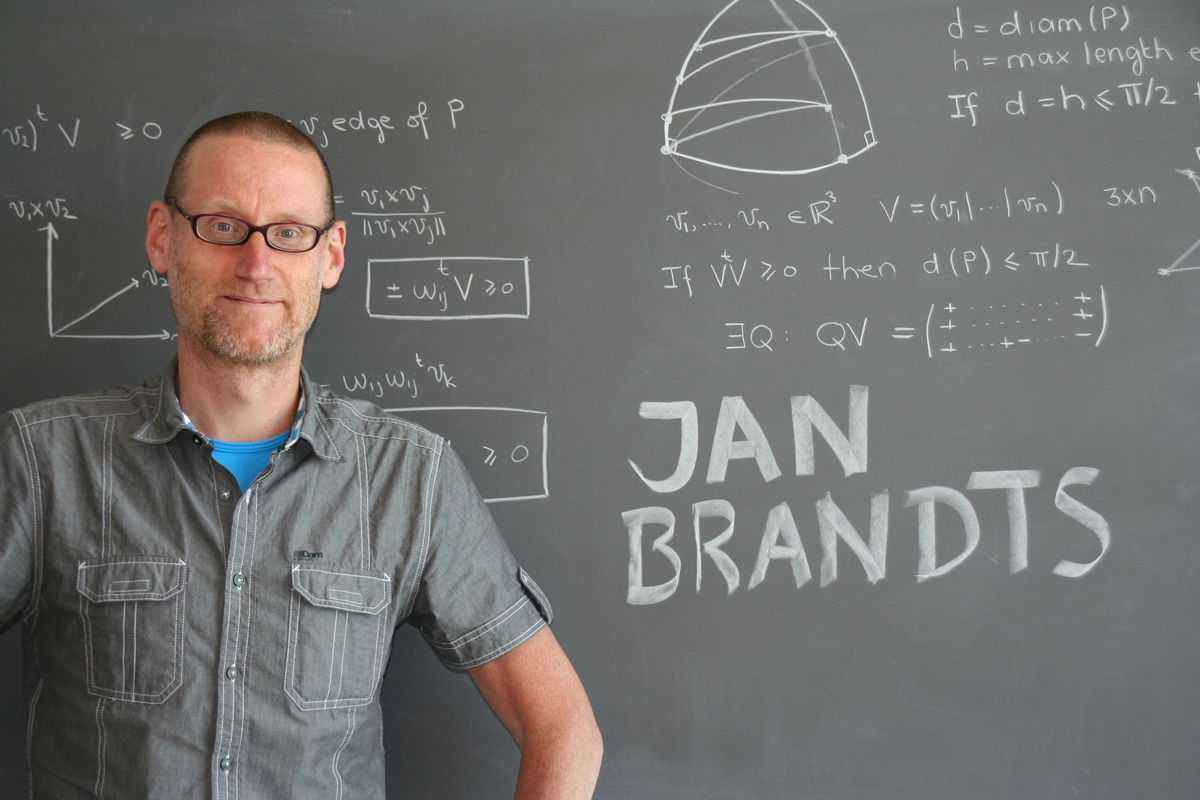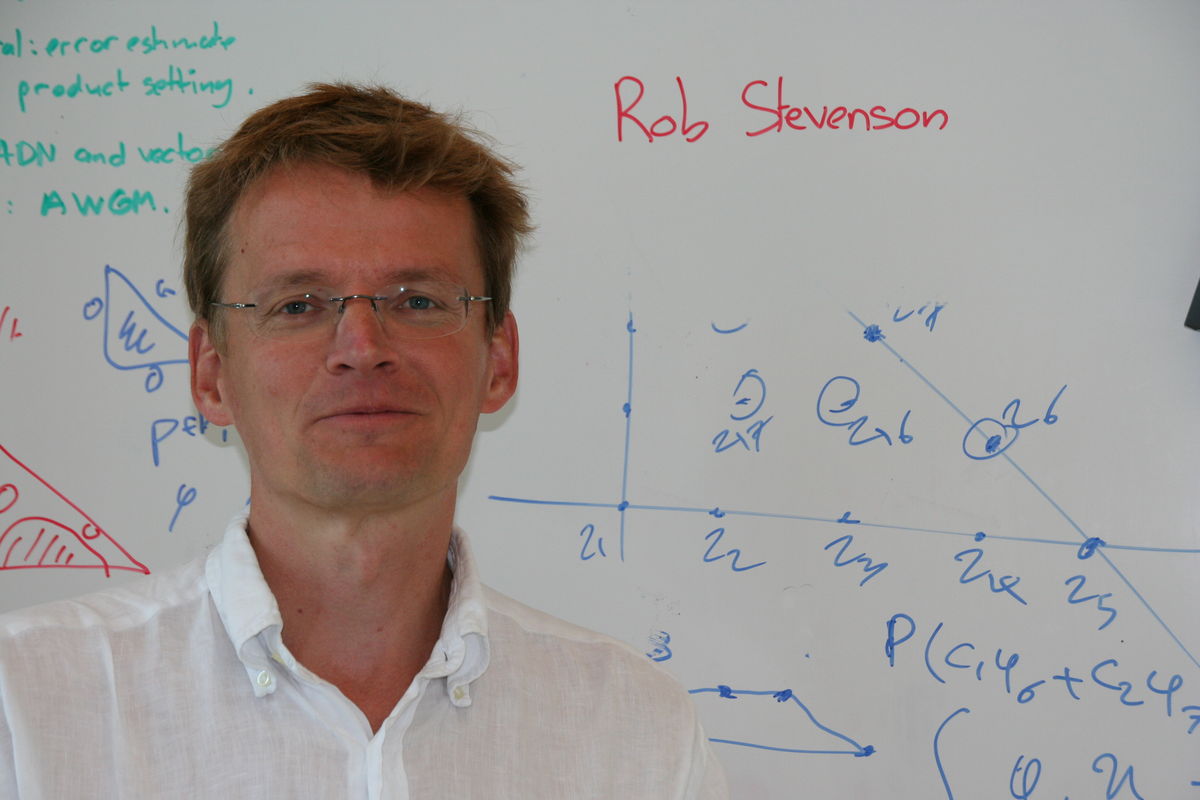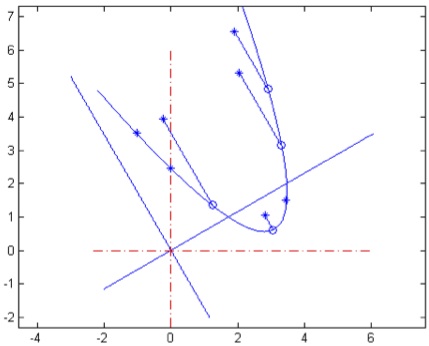

Ricardo Reis da Silva

Jan Brandts

Rob Stevenson
Redacteur: Geertje Hek
G.M.Hek at uva.nl
Eerder verschenen in
Nieuw Archief voor Wiskunde, september 2011, pp. 188–189.
Matrix
perturbations, bounding and computing eigenvalues
Ricardo Reis da Silva
Originally from Portugal, Ricardo Reis da Silva came to Utrecht to do his master studies. He then continued as a Ph.D. student at the Universiteit van Amsterdam. Despite the natural ups and downs, he has enjoyed his time in the Netherlands. “The country has a good research and academic environment and I was fortunate enough to work alongside some of the top researchers in my area.” He felt very welcome, both at the Mathematics Department in Utrecht as an international student as well as at the Korteweg-de Vries Institute in Amsterdam as a Ph.D. candidate. But more important than the particular place or the particular work he did, was the global experience of living abroad. That was surely not what he had expected when he first moved here. It was, however, precisely the fact that he encountered so many unexpected things, that made the whole experience so valuable.
Matrix and eigenvalue perturbations
On June 10th, Reis da Silva successfully defended his Ph. D. thesis
Matrix Perturbations, bounding and computing eigenvalues,
written under guidance of dr. Jan Brandts and prof. dr. Rob Stevenson at
the Universiteit van Amsterdam.
His thesis belongs to the areas of Linear Algebra and Numerical Linear
Algebra and its contents are divided into two parts covering two
distinct though related topics.
The first part is on matrix and eigenvalue perturbation theory. In
this part he studies amongst others Hermitian rank-k perturbations
of Hermitian matrices and their eigenvalues. The study of such
matrices and perturbations has a background in numerical methods for
partial differential equations. For instance, the Finite Difference
discretisation of certain reaction-diffusions differential equations
yields a standard positive definite Hermitian tridiagonal matrix
resulting from the diffusion part. This discretisation can also yield
a rank-k Hermitian matrix resulting from the reaction part, which
can be seen as a perturbation of the diffusion Hermitian matrix. The
study of matrix perturbations is, however, also relevant for the
analysis of iterative methods for eigenvalue problems.
For Hermitian perturbations of Hermitian matrices much is known about
the relative position of the eigenvalues after perturbation. The
results follow from the variational characterisation of the
eigenvalues given by the Courant-Fischer theorem, from Weyl's
inequalities bounding the eigenvalues of the resulting matrix by those
of the original and the perturbation matrices, and to some extent also
from the Cauchy Interlace Theorem on the interlacing property between
the eigenvalues of a matrix and of its n−1 principal
submatrix. These are all well know and useful results for Hermitian
matrices.
For Hermitian rank-k perturbations of Hermitian matrices, Reis da
Silva developed Weyl-type bounds for the eigenvalues, that are tighter
than Weyl's classical bounds while the additional computational costs
are very modest. He then used the same technique to obtain bounds for
the eigenvalues of arrowhead matrices (square matrix whose entries are
all zero except for the diagonal and the first row and column) and for
the singular values of perturbed rectangular matrices.
Normality preserving perturbations
For normal matrices much less is known than for Hermitian
matrices. For example, given two normal matrices A and E, it is
still not fully understood under which conditions A+E is also
normal.
In chapter 3 of his thesis, Reis da Silva makes inroads in that
direction. He studies normality preserving perturbations and
augmentations
of normal matrices and their consequences to the eigenvalues. Ikramov
and Elsner had studied normality preserving augmentations (adding
additional rows and columns) of normal matrices before, but nothing
was known about their impact on the eigenvalues. In Reis da Silva's
thesis it is shown how the eigenvalues of the original matrix are
influenced by the augmentation, and moreover, bounds for them are
found. Next, normality preserving normal perturbations are
studied. For 2×2 and for rank-one matrices, the analysis is
now complete. For higher rank, all essentially Hermitian (normal
matrices with collinear eigenvalues) normality preserving
perturbations are described. And finally, using the stratification of
normal matrices presented by Huhtanen in 2001, Reis da Silva
constructed all augmentations that result in normal matrices with
eigenvalues on a quadratic curve in the complex plane.
In his opinion, these results on perturbations of normal matrices are
his most interesting results. They appear to resemble
those we known for Hermitian matrices and will hopefully motivate
others to look more closely into perturbations of normal matrices.

Analysis of a method developed by chemists
Part two of the thesis focusses on iterative methods for eigenvalue
problems and, in particular, on the analysis of a somewhat unknown
method, the Subspace Projected Approximate Matrix method. This method
was developed by chemists and is a relatively recent (2001) iterative
method for eigenvalue problems. The introduction of the method and the
first results of numerical experiments for chemical applications were
promising. However, the method had not yet been analysed from a
Numerical Linear Algebra point of view and it was mostly tested in
comparison with Davidson's method. It was, thus, unclear whether it
could serve as an alternative to well-known methods like
Jacobi-Davidson or Lanczos. In Reis da Silva's thesis it is shown that
despite some interesting characteristics it cannot. Another result is,
that for certain choices of the preconditioner SPAM is mathematically
equivalent to Lanczos method.
The next step
Reis da Silva enjoyed being a Ph.D. candidate. He especially found the
combination of learning and being responsible for his own learning
process valuable. He also welcomed the additional responsibilities
such as teaching.
There were several ups and downs during his Ph.D. time. The hardest
period was when he was about halfway his four years. He suddenly
realised that the time ahead was shorter than the time already spent
on the research, while his actual results were not half of what would
be needed in the end. Other Ph.D. candidates had shared similar
experiences with him, but it was still quite a shock to actually go
through this period. The climax of his time at the UvA was indeed to
have sent the manuscript to the printer. Just after his thesis
defence, he had not yet in mind what would be the next step in his
career. But for a while at least he wants to take some distance from
doing research and try something different. And after almost six years
in the Netherlands he also thinks it is time to move to another
(hopefully warmer) location.